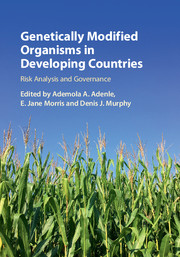Book contents
- Genetically Modified Organisms in Developing CountriesRisk Analysis and Governance
- Genetically Modified Organisms in Developing Countries
- Copyright page
- Contents
- Contributors
- Foreword
- 1 Introduction
- Part I Risk Analysis Methodology and Decision-Making
- 2 Recent Scientific Developments in Genetic Technologies: Implications for Future Regulation of GMOs in Developing Countries
- 3 A Strategy for Integrating Science into Regulatory Decision-Making for GMOs
- 4 Governance of Benefits and Risks of GMOs in Developing Countries
- 5 The Canadian Experience with the Creation and Implementation of Regulatory Frameworks for the Environmental Release of GM Crops as a Model for Developing Countries
- 6 Labelling of Food from GMOs: Options to Consider by Developing Countries
- 7 Building Human Capacity and Skills in Biosafety: Lessons Learned and Emerging Best Practices
- Part II Diversification of Expertise
- Part III Risk-Analysis-Based Regulatory Systems
- Part IV Case Studies from Developing Countries
- Index
- References
7 - Building Human Capacity and Skills in Biosafety: Lessons Learned and Emerging Best Practices
from Part I - Risk Analysis Methodology and Decision-Making
Published online by Cambridge University Press: 05 July 2017
- Genetically Modified Organisms in Developing CountriesRisk Analysis and Governance
- Genetically Modified Organisms in Developing Countries
- Copyright page
- Contents
- Contributors
- Foreword
- 1 Introduction
- Part I Risk Analysis Methodology and Decision-Making
- 2 Recent Scientific Developments in Genetic Technologies: Implications for Future Regulation of GMOs in Developing Countries
- 3 A Strategy for Integrating Science into Regulatory Decision-Making for GMOs
- 4 Governance of Benefits and Risks of GMOs in Developing Countries
- 5 The Canadian Experience with the Creation and Implementation of Regulatory Frameworks for the Environmental Release of GM Crops as a Model for Developing Countries
- 6 Labelling of Food from GMOs: Options to Consider by Developing Countries
- 7 Building Human Capacity and Skills in Biosafety: Lessons Learned and Emerging Best Practices
- Part II Diversification of Expertise
- Part III Risk-Analysis-Based Regulatory Systems
- Part IV Case Studies from Developing Countries
- Index
- References
Summary
- Type
- Chapter
- Information
- Genetically Modified Organisms in Developing CountriesRisk Analysis and Governance, pp. 75 - 88Publisher: Cambridge University PressPrint publication year: 2017
References
- 1
- Cited by



